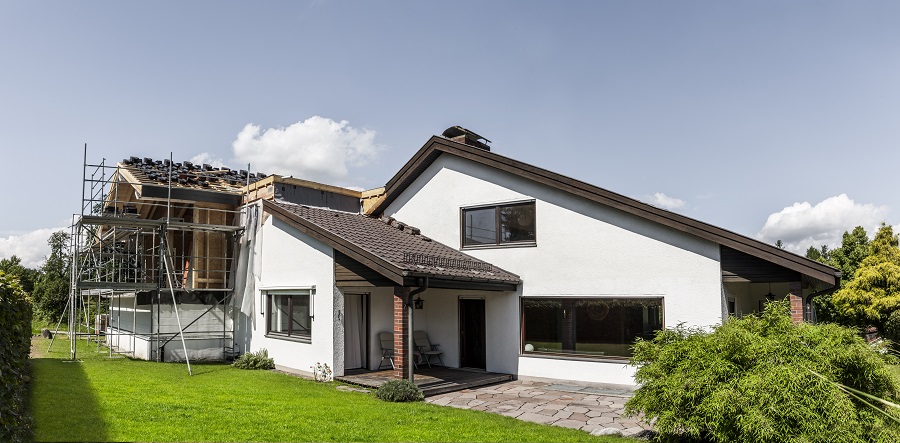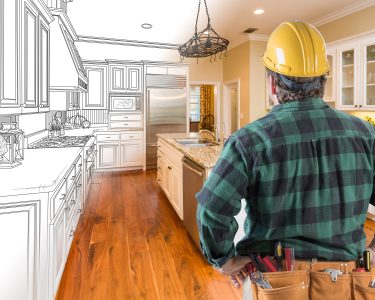The timelines for building home additions heavily depends on project size, permits, weather, and your contractor, but generally takes between 2-6 months.
Smaller projects like bump-outs might take only 2 months, while larger additions like second stories can take 6 months or more.
Of course, home additions are huge time and money investments. Whatever you’re planning, understanding how long it’ll take is a big help when preparing for the build.
Let’s take a look at the house extension timeframe for different types of additions and what affects your schedule.
Common Questions About Home Addition Timelines
How long does a typical home addition take from start to finish?
Most home additions take between 2-6 months total, including planning, permits, and construction. Smaller projects finish faster, while larger or more complex additions take longer.
What’s the fastest type of home addition to build?
Bump-out additions (extending a room by a few feet) are the fastest, usually taking 4-6 weeks for construction. Small sunrooms and enclosed porches also go relatively quickly, usually finished in 6-8 weeks.
How long does a kitchen extension take?
A kitchen extension usually takes 8-12 weeks for construction plus 4-6 weeks for planning and permits. Kitchens need several inspections and specialized work (plumbing, electrical, cabinetry), which adds time.
What’s the timeline for a second story addition?
A second story addition is one of the longest projects, spanning 12-24 weeks for construction alone. With planning and permits, expect 5-8 months total for a complete second floor.
What Affects Your Home Addition Timeline?
These key factors determine how long your project will take:
Project Size and Type:
- Smaller additions (under 200 sq ft) = Faster completion
- Larger additions (over 500 sq ft) = Longer timeline
- Complex designs = More time needed
Permits and Approvals:
- Simple projects = 1-2 weeks for permits
- Complex or historical homes = Up to 8 weeks for approvals
- Failed inspections = Added delays
Contractor Factors:
- Experienced contractors using modern technology = Faster, more efficient work
- Contractor availability = Affects start date and scheduling
- Subcontractor coordination = Can create bottlenecks
Weather Conditions:
- Good weather = Steady progress
- Rain/snow = Delays outdoor work
- Extreme temperatures = Affects material curing and installation
Materials and Supply Chain:
- Standard materials = Quicker availability
- Custom or specialty items = Longer lead times
- Supply chain issues = Unpredictable delays
Homeowner Decisions:
- Quick decision-making = Keeps project moving
- Changes during construction = Causes delays and rework
- Payment delays = Can pause construction
Home Addition Timeline: Planning Phase (2-6 Weeks)
Before any construction begins, you’ll need to complete the planning phase. This usually takes 2-6 weeks and includes:
- Meeting with contractors and designers
- Creating and finalizing floor plans
- Setting your budget
- Choosing materials, fixtures, and finishes
- Getting HOA approvals (if needed)
If you know exactly what you want and your contractor has in-house design services, this phase moves much faster. It’ll take longer if you need to get approvals or revise the design several times.
Permit Timeline for Home Additions (1-8 Weeks)
After planning comes the permit process. How long permits take depends on your local building department:
- Building permits: 1-8 weeks
- Electrical, plumbing, and HVAC permits: 1-4 weeks
- Zoning approvals: 2-8 weeks
- Environmental or historic reviews: 4-12 weeks (if required)
Some cities offer fast-track permitting that takes a few days, while others may take months. Having complete, professional plans speeds up the process. Incomplete applications or plans that don’t meet code requirements will delay the project.
Construction Timeline by Home Addition Type
Here’s how long the actual building phase usually takes for different types of additions:
- Bump-out (adding a few feet): 4-6 weeks
- Sunroom or enclosed porch: 6-8 weeks
- Single room addition (bedroom/office): 8-12 weeks
- Kitchen extension: 10-14 weeks
- Bathroom addition: 8-12 weeks
- Garage conversion: 8-10 weeks
- New garage with living space: 12-16 weeks
- In-law suite or accessory dwelling: 12-16 weeks
- Second-story addition: 12-24 weeks
Remember that these timeframes don’t include planning or permits. Also, bad weather, material delays, or inspection issues can make them take longer.
8 Stages of Building a Home Addition (with Timeframes)
Home addition construction follows these main stages:
- Site Preparation and Demolition (1-2 weeks)
- Clearing the construction area
- Removing existing walls or structures
- Setting up temporary supports
- Foundation Work (1-2 weeks)
- Digging footings
- Pouring concrete foundation
- Waterproofing
- Framing (1-3 weeks)
- Building the basic structure
- Installing roof trusses
- Adding exterior sheathing
- Rough-Ins (1-2 weeks)
- Running electrical wires
- Installing plumbing pipes
- Setting up HVAC ductwork
- Inspections (3-7 days)
- Framing inspection
- Electrical, plumbing, and HVAC inspections
- Insulation inspection
- Insulation and Drywall (1-2 weeks)
- Installing insulation
- Hanging and finishing drywall
- Prepping for paint
- Interior Finishes and Flooring (2-4 weeks)
- Painting walls and trim
- Installing flooring
- Adding cabinets and fixtures
- Finishing electrical and plumbing
- Final Inspections and Walkthrough (1 week)
- Final building inspection
- Fixing punch list items
- Final cleanup
Some of these stages may overlap, but each requires specific skills. They also need to be done in the right order. You can’t put insulation in before the walls are up.
How to Speed Up Your Home Addition Project
It’s impossible to avoid some delays, but here are a few steps you can take to minimize home addition delays:
- Make decisions early: Choose all materials and finishes before construction starts
- Order long-lead items first: Windows, doors, and custom cabinets can take weeks to arrive
- Be available: Respond quickly to contractor questions
- Avoid changes: Changing plans mid-project causes significant delays
- Schedule inspections promptly: Book inspections as soon as each phase is ready
- Consider prefabricated options: Factory-built components can reduce on-site construction time
- Choose readily available materials: Custom or rare materials often have long lead times
Best Time of Year for Home Addition Projects
The season affects how long your home addition takes and costs:
- Spring (March-May): Good starting time, but rain may delay foundation work
- Summer (June-August): Ideal for most construction, but contractors may be fully booked
- Fall (September-November): Good weather, but finish before winter if possible
- Winter (December-February): Slowest season with weather delays, but sometimes better contractor availability
For best results, try to schedule foundation and framing during dry months, and interior work during worse weather seasons.
Can You Live in Your Home During an Addition?
This common question depends on your project type:
- Separate additions (like a new garage or bump-out): Yes, you can usually stay in your home
- Second-story additions: Often need temporary relocation
- Major renovations (that affect plumbing/electrical): Might need partial relocation
- Kitchen additions: May need temporary kitchen setup elsewhere
Talk about this with your contractor as early in the process as possible to prepare accordingly.
Home Additions Timeline FAQ
How long does it take to build a master bedroom addition?
A master bedroom addition typically takes 8-12 weeks for construction plus 3-6 weeks for planning and permits. If you’re adding a master bathroom too, add another 2-4 weeks.
Do bathroom additions take longer than other rooms?
Yes, bathroom additions usually take longer than similar-sized rooms because of the plumbing, electrical, and waterproofing requirements. Those requirements also necessitate inspections.
What causes the biggest delays in home addition projects?
The biggest delays come from permit issues, weather problems, material backorders, failing inspections, and homeowner-requested changes during construction.
How can I tell if my home addition is on schedule?
Ask your contractor for a detailed timeline at the start, with major milestones marked. Then check progress against this schedule weekly. Professional contractors should provide regular updates.
Are prefab or modular additions faster?
Yes, prefabricated additions can reduce construction time significantly. But, you still need time for site prep, foundation, and final connections.
What to Remember About Home Addition Timelines
Adding space to your home takes time, but the results are worth the wait. Expect your home addition timeline to span 2-6 months from design to completion, depending on the project size and complexity.
Remember these key points:
- Smaller projects like bump-outs take 2-3 months total
- Mid-sized additions like bedrooms or family rooms take 3-4 months
- Large additions like second stories or in-law suites take 5-8 months
- Planning and permits take as much time as actual construction
- Weather, materials, and decisions all affect your timeline
By understanding the typical house extension timeframe, you can plan better and set realistic expectations for your home improvement project.




